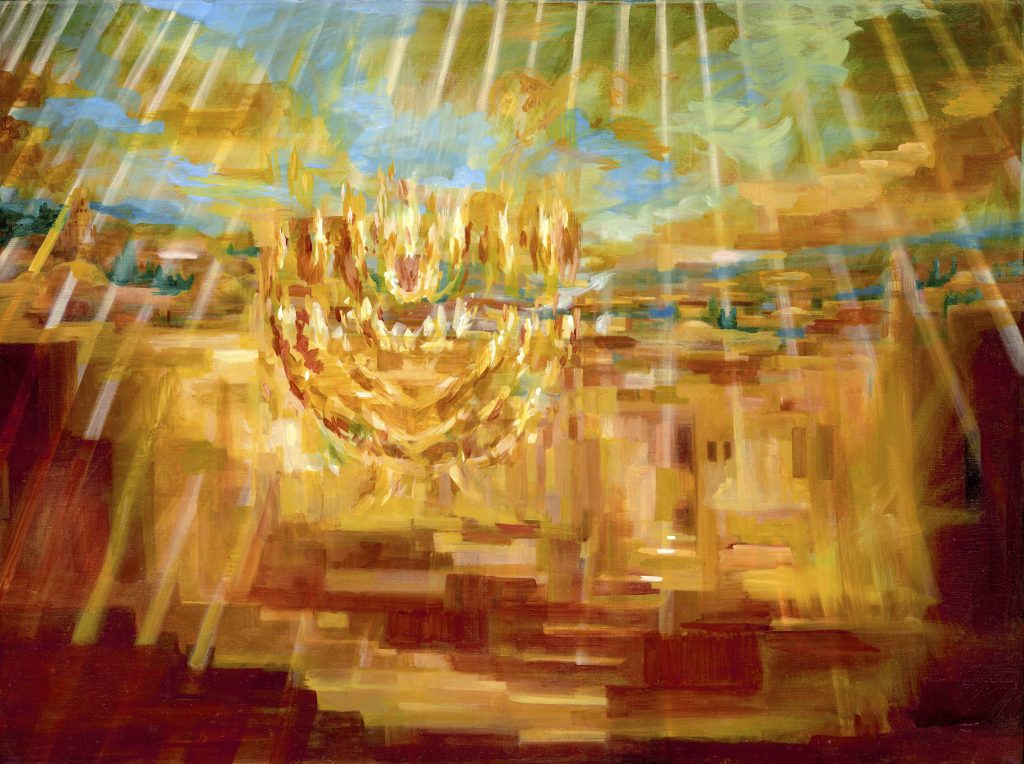Chanukah: I See the Light

“Jerusalem Menorah,” copyright © 2019, yoramraanan.com. This painting is by artist Yoram Raanan, who was featured in the winter 2018 issue of this magazine.
If someone “enlightens” me, this means I see the point. Or even I see the truth.
But what if I “see” literally, not figuratively? What if, when I “see the light”—when I am enlightened—this is not a figure of speech? What if it signifies light, as in flames or sun rays?
I saw the light recently when I threw away my whole life; more precisely, my ophthalmologist threw it away. As a consequence of surgery on each of my eyes, I am now struck by light, and also by how “light” has been taken as a Jewish metaphor for spirituality but may be more than a metaphor.
Indeed, I see the light every moment. Dramatic beauty strikes me every morning as I awaken and gaze out the window at nothing particularly beautiful. The grass and the trees out there do not need to be beautiful. It is the light, embracing and enveloping in a way I had never seen before. I have no adjective for this. Any word I might summon—luminescent, translucent, gorgeous light—does not begin to describe what is now my daily gift.
Truth be told, the grass and the trees are also dramatically different. I no longer see a tree; I discern the shape and topography of each single leaf. God has etched every object, animate and inanimate, and I now discern its individuality. Colors? I thought I knew colors. How little did I know the astoundingly beautiful world, as colors now blaze before my eyes. My wife is used to what surely must seem like irrational outbursts as I cannot help but phone her as I drive to or from work.
“The bricks!” I exclaim. On homes or buildings along the streets I drive, I now discern each brick in its specific shape, texture and shade, rather than the blurred side of a building.
“That stop sign!” I exclaim. The redness of the sign jumps out at me. Pure, deep, striking red. Greens, yellows, blues and purples leap out at me. I see black as I never saw it before. I marvel at the way new black cars gleam; the way the burnish on my tefillin straps is transfigured. I see white as I never saw it before, especially when I’m reading. With the blackness of the letters blacker than ever before and the whiteness of the page whiter than ever before, the act of reading has become an overwhelmingly aesthetic experience, wholly apart from the substance of what I read. I see the light!
Which brings me to light as a metaphor. I always understood the “Divine light” to be a metaphor, and no doubt it is. But after surgery, it is not only a metaphor.
Colors? I thought I knew colors. How little did I know the astoundingly beautiful world, as colors now blaze before my eyes.
Example: Kabbalists speak of our universe, our material world, as unable to be purely spiritual, as necessarily material, since the Divine light is too intense for the human being to absorb. Humans need materiality to coarsen the Divine light, to blunt it, so that it does not overwhelm and blind us. I get it. I now understand light as able to change in character because I now see light as less coarsened, purer than any light I have ever seen. Perhaps, with surgically corrected vision, I merely see what everyone else already sees; still, the contrast between my sight before and after surgery establishes the truth of the Kabbalah. Light is more than metaphor, more than language needed by theologians to express how an infinite God creates a finite universe. Light, yes, can acquire a palpable presence, not just abstract meaning. I said before that I have no adjective for this; the closest I can come to describing the light I now see is El Greco’s View of Toledo.
Another example: “Let there be light” (Genesis 1:3). With that primordial light, Adam, the first human being, saw “from one end of the world to the other,” says the Midrash. However, Adam’s immeasurable sight endured for only thirty-six hours, after which God “hid” the original light, saving it for “the future to come” (le’atid lavo). If that future is inaccessible, the nature of that light is also inaccessible. But “the future to come” is not only a metaphor for an ultimate perfection, says the Slonimer Rebbe, citing the Zohar. The “future to come” includes every Shabbos, as well as the capacity of tzaddikim to access God’s hidden light. If this “light” signifies not just insight but light, then each person who is Sabbath-observant, and all people in their holiest moments as one of the tzaddikim, can “see the light,” literally.
This year, on Chanukah, I will see different lights. I already know this from the Shabbos candles. Before my surgery, they used to burn with a dark yellowish tint, black at the base of the flame. Now, they blaze in white, blue at the base. White light. Pure, deep, striking white light.
Surely, the Chanukah candles will not be less. I will see their white light.
Our Chanukah menorah, whose flames represent the oil used in the ancient Holy Temple’s menorah, tells us that in the most spiritual spot on earth, light was a necessity. It was the light of the menorah; the light we see. It was also the locus of the Divine light; the metaphor. Both, together.
Rabbi Dr. Hillel Goldberg is the editor of the Intermountain Jewish News and a contributing editor of Jewish Action.
